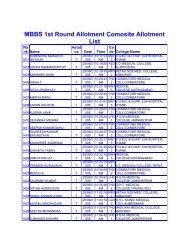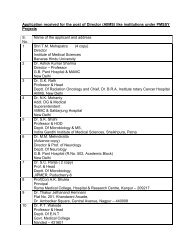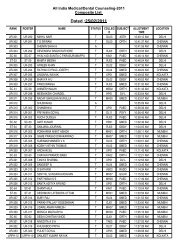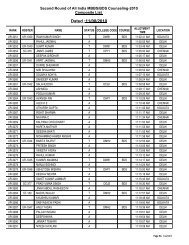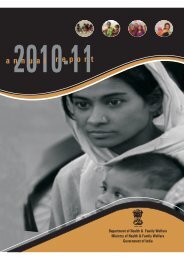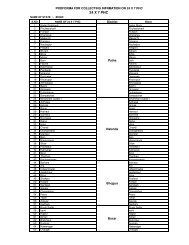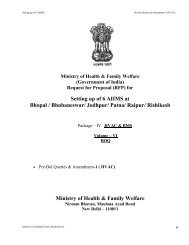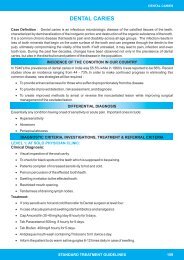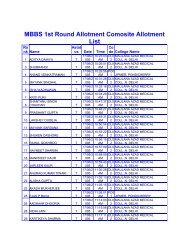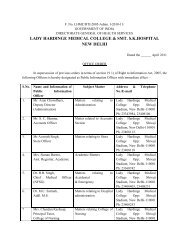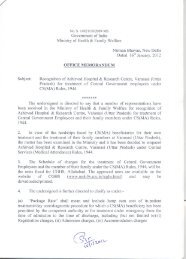National Vaccine Policy Book - Ministry of Health and Family Welfare
National Vaccine Policy Book - Ministry of Health and Family Welfare
National Vaccine Policy Book - Ministry of Health and Family Welfare
You also want an ePaper? Increase the reach of your titles
YUMPU automatically turns print PDFs into web optimized ePapers that Google loves.
6. OPERATIONAL EFFICIENCY OF UIP<br />
6.1. Improving vaccine coverage<br />
The coverage <strong>of</strong> UIP vaccines in this country is >70% only in 11<br />
states, 50-70% in 13 <strong>and</strong> below 50 % in the rest <strong>of</strong> the 8 states. The<br />
last group also happens to include the most populous states, which<br />
brings down the national average below 50%. This is an area <strong>of</strong><br />
concern <strong>and</strong> issues need to be addressed to improve UIP program<br />
performance.<br />
• An assessment <strong>of</strong> existing bottlenecks that impede success in<br />
UIP should be carried out by an independent agency.<br />
• An in-depth assessment <strong>of</strong> the immunization systems in the<br />
states should be carried out to underst<strong>and</strong> the better outcomes in<br />
a few versus the abysmal performance in others. Similarly, the<br />
neighboring country structures (e.g., Sri Lanka <strong>and</strong> Bangladesh<br />
etc.) should also be studied to learn from them.<br />
• A systematic registration <strong>and</strong> identification <strong>of</strong> pregnancies <strong>and</strong><br />
births along with computerization <strong>of</strong> data for data-management<br />
will be useful to facilitate reaching the every new cohort <strong>of</strong><br />
children.<br />
• Linking <strong>of</strong> the Geographical Information System (GIS) with UIP<br />
network can also be used to track delivery <strong>of</strong> vaccines.<br />
• The strengths <strong>and</strong> gains from <strong>National</strong> Rural <strong>Health</strong> Mission<br />
(NHRM) in improving coverage <strong>of</strong> vaccination in certain states<br />
should be consolidated. The ANMs should be adequately<br />
incentivized to contribute to increasing coverage<br />
6.2. AEFI surveillance system<br />
The vaccines are administered as preventive measures to healthy<br />
individuals particularly children. The adverse events following<br />
immunization (AEFI) should be h<strong>and</strong>led effectively in order to<br />
maintain/restore public faith in immunization program. The national<br />
operational guidelines on AEFI surveillance has been updated in<br />
2010 <strong>and</strong> widely disseminated. All states <strong>and</strong> districts are now<br />
required to constitute AEFI committees, which assist in streamlining<br />
the reporting mechanism, investigate the reported serious AEFI <strong>and</strong><br />
are involved in the causality assessment.<br />
• The capacity building in AEFI surveillance <strong>and</strong> case investigation<br />
should be done in the entire country. The national <strong>and</strong> state level<br />
should have sufficient capacity to conduct causality assessment<br />
for AEFI. A mid term plan for capacity building should be prepared.<br />
• There is need for establishing a strong mechanism for AEFI<br />
surveillance between immunization division <strong>and</strong> DCGI. The Post<br />
Marketing Surveillance (PMS) network being set in Maharashtra<br />
state should be used for strengthening AEFI surveillance in the<br />
entire country. Post marketing surveillance (PMS) <strong>of</strong> AEFI is also<br />
important to generate new hypotheses about vaccine reactions<br />
that are specific to the population. The experiences from Global<br />
PMS network in Maharashtra state could help in developing<br />
model practices at the state level.<br />
• Effective collaboration <strong>and</strong> effective communication between<br />
<strong>National</strong> Control Laboratory, the <strong>National</strong> Immunization Program<br />
(NIP), <strong>and</strong> DCGI <strong>of</strong>fice should be established <strong>and</strong> quick<br />
identification <strong>and</strong> resolution <strong>of</strong> a vaccine batch related problem.<br />
Clarity <strong>of</strong> responsibilities <strong>and</strong> good liaison system between NRA<br />
<strong>and</strong> NIP is required <strong>and</strong> revised TOR <strong>of</strong> the immunization staff at<br />
all levels to delegate their role in the AEFI reporting has to be<br />
prepared.<br />
• The Central Drug Laboratory at Kasauli, which is currently used<br />
for testing for vaccine samples in AEFI, should be upgraded <strong>and</strong><br />
efforts should be made to get NABL certification.<br />
• <strong>National</strong> Immunization Program (NIP) <strong>and</strong> <strong>National</strong> Regulatory<br />
Authority (NRA) should be provided with adequately trained<br />
human resource to manage <strong>and</strong> coordinate immunization safety<br />
initiatives.<br />
• The national AEFI secretariat needs to be set in India. This may be<br />
established at <strong>National</strong> Centre for Diseases Control or similar<br />
identified institution. This secretariat would establish the links with<br />
the Brighton Collaboration <strong>and</strong> Global Advisory Committee on<br />
<strong>Vaccine</strong> Safety (GACVS) to further strengthen AEFI surveillance<br />
in India.<br />
6.3. VPD surveillance<br />
<strong>Vaccine</strong> Preventable Diseases (VPD) surveillance system in India is<br />
weak <strong>and</strong> needs to be strengthened to create an evidence base to<br />
20 21




